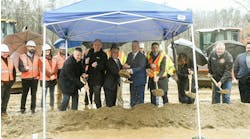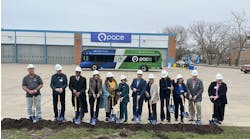The original mission of the Transportation Resource Information Point, or TRIP, was to help people explore and use transportation alternatives throughout Central Maryland. In Maryland, the Maryland Transit Administration (MTA) was the designated recipient of Section 5316, the Job Access and Reverse Commute (JARC) program funds, and worked in conjunction with Central Maryland Regional Transit (CMRT) to begin the buildout of a transportation database, now known as TRIP.
By using census data and information provided by transportation and human services providers, CMRT and the MTA assessed the transportation needs, issues and constraints of the general public, as well as of older adults, people with disabilities and people with lower incomes. In fiscal year 2010-2011, CMRT received additional funds to hire and train the personnel to move TRIP forward. To this day, CMRT continues to build the TRIP program.
The TRIP website (mdtrip.org) is composed of information that CMRT has collected from various service providers in the Baltimore metropolitan area, so viewers can quickly see a variety of transportation options on one easy-to-use website. The project also features the TRIP Regional Information Center: 1-877-331-TRIP (8747). Customers, human services agencies and partner organizations can dial this number for immediate information and assistance.
In 2011, CMRT was awarded a Veterans Transportation and Community Living Initiative (VTCLI) grant to extend the TRIP program from Central Maryland to the entire state. The aim of the project was to use the General Transit Feed Specification (GTFS) data format (used for trip planners such as Google Maps, Yahoo Maps, Bing Maps, Apple Maps, others, as well as third-party app developers) to make all of Maryland’s locally operated transit systems published, available and accessible to veterans, individuals with disabilities, senior citizens, low-income commuters, and the general public, including international tourists.
Through the course of the 12-month project, the TRIP team hired a project manager to coordinate the project efforts; trained and deployed three GIS data technicians who completed the bulk of the project scope in half the time, and completed 18 transit systems’ worth of GTFS feeds for systems in the state of Maryland. This represented an over 90 percent increase over the number of published feeds available in Maryland prior to the CMRT grant.
Developed by Google, using data generated from TriMet in Portland, Oregon, the General Transit Feed Specification (GTFS) exists today as a commonly used, standardized, digitized format of transit data. GTFS feeds allow transportation agencies from around the world the ability to publicly display their transit data and schedules via Google Maps or other trip-planning services. GTFS feeds come in a zipped folder containing a series of text files that correspond to a transit organization’s specific data attributes, such as route stops, routes, trips and scheduled data.
The TRIP team at CMRT decided to utilize the National Rural Transit Assistance Program’s (RTAP) GTFS Builder in order to generate transit feeds from around the state of Maryland because of its overall simplicity and no-cost arrangement. The GTFS Builder Toolset includes both Excel spreadsheet-based data management tools and step-by-step instructional videos, making even the least tech-savvy individuals comfortable working with GTFS feeds. Once a transit agency has validated its feed and requested its own Google Transit account to test its data, the feed is then sent to Google Transit and eventually published.
GTFS, and our GTFS efforts in Maryland, are critically important to a number of vulnerable populations. For transit-dependent riders with low-English proficiency, GTFS through Google Maps or through third-party applications is able to automatically translate the information provided in English to more than 100 other languages, allowing these individuals access to crucial transit information and access to jobs, healthcare and more. Because GTFS can function in a way that makes transit information so much more accessible, it also can accommodate transit agencies’ Title VI requirements, and can be provided in a way that allows individuals with visual impairments to use screen readers.
The Numbers Tell the Story
Because of the TRIP team’s work, 187 routes for 18 systems have been placed onto Google Transit and are fully accurate, up-to-date and functional. Prior to the TRIP project, someone viewing a route in Cumberland was greeted with a short trip that took 4 hours, 58 minutes. This represented an error in the GTFS work. TRIP corrected the data, and reviewed additional information prior to submitting the work to Google Transit. One can now view the same trip, which takes far less time. This valuable effort serves transit-dependent populations throughout the state, and commuters will now have accurate information allowing them to make regional connections.
While the challenging work of creating and validating the information has been completed, the project has only just begun. Transit data is only effective when it is accurate and up to date, which is why the TRIP team trained representatives from each of the transit systems to maintain the data. For those who would like additional assistance, TRIP has recently received new 5310 funding to maintain these GTFS feeds in Maryland.
This project allows CMRT’s TRIP team to work with communities and agencies across the state to determine critical transit deficiencies in existing routes, and determine ways to improve access. Some of the more telling concerns are highlighted once GTFS information is live and interactive. For example, an individual trying to access a job at Fort Meade from their home in Columbia faces a series of bus routes and transfers as part of an everyday commute. The GTFS work that was completed by the TRIP team enables agencies to analyze areas needing improvement, identify communities isolated from transit and develop opportunities for interagency cooperation.
The local transportation systems throughout Maryland have already benefited immensely from this project. Our team’s work has a direct impact on 18 distinct systems in the state, covering 187 routes. Prior to the project, a transit-dependent user would be shown no available transit options between rural and urban destinations. A trip originating in Westminster, Ocean City or many other communities would show no possible trip options other than driving.
The many outcomes for local transportation systems are substantial, and reflect the diversity of transit systems. From small systems with only one route, like Maryland Transit Connection’s Metro Connector in Carroll County, to the Regional Transportation Agency of Central Maryland with 15 routes that service parts of four counties.
The hands-on work done by our team also identified places where transit information was incorrect or outdated — especially important quality assurance work that was completed at no cost to the locally operated transit systems. For example, route scouting and bus stop location geocoding in Carroll County helped Carroll Transit System (CTS) identify stops that were outdated and enabled removal of signs. This information was updated within the CTS system, and was done with no time or financial expense by the agency.
Finally, this project in many cases represented the first iteration of digital transportation data for some of the smaller and more rural transit systems involved. This allows the opportunity to develop better scheduling and routing, and creates for the first time shapefiles that can be used in GIS or the National Transit Map and other applications of information technology. The following highlights additional benefits of digitizing bus schedules into GTFS.
a. Coordination:
This project represented an unprecedented level of coordination between CMRT and the numerous locally operated transit systems in Maryland. Because of the nature of the GTFS work, the coordination between agencies was crucial. The only way for the project to succeed was through commitment to the utmost level of openness regarding data, and clear communication between all parties.
b. Innovations:
This project represents forward progress for the whole state of Maryland. Prior to this project, very few systems had any GTFS available, and only the large, well-funded systems were available on Google Maps. A visitor to Maryland would find that, at first glance, there was no public transportation outside of Baltimore or Washington, and no connections could be made to suburban and rural communities. Because of Maryland’s geographic proximity to the Nation’s Capital, the need to demonstrate connectivity within and throughout the region is crucial.
As a result of limited financial and time resources within transit agencies; GTFS and public transit data are often forgotten, incomplete, or out-of-date. Because many third-party application developers rely on current and accurate GTFS data to create tools, applications and resources, the need for such data cannot be understated.
With this in mind, there are very few states that have all of their transit information provided to the public in the GTFS format. Maryland, through the TRIP project, is the first state to create these feeds for transit agencies for no cost, using tools that most transit agencies already have access to.
Finally, having transit data in a GTFS format makes information more accessible. For individuals with disabilities who rely on paratransit, having descriptive and interactive directions can open new doors to personal freedom on fixed route systems. For those with differing visual abilities, GTFS can serve as the baseline for wayfinding applications and can provide information on cardinal directions, distances, and transfer points. Google Maps also translates directions into numerous languages, allowing low-English proficiency and non-native speakers to have access to transportation information in their own language.
c. Community Partnerships
The professionals on our team were mindful of the challenges of training colleagues at the local transit systems. The team approached this portion of the project with a keen understanding of limited staff time and resources at the transit agencies and were available and flexible throughout to better support these agencies. The team also worked hard to incorporate advanced technology with a more human twist, promoting a deeper understanding of the work and why it was important to the agencies’ users, all while communicating with the agencies in a way that ensured they felt valued and understood. This programmatic effort represents enhanced partnerships and collaboration throughout not only the Central Maryland region, but the entire state.
Jaime McKay is the interim manager of Direct Services at Central Maryland Regional Transit (CMRT).


